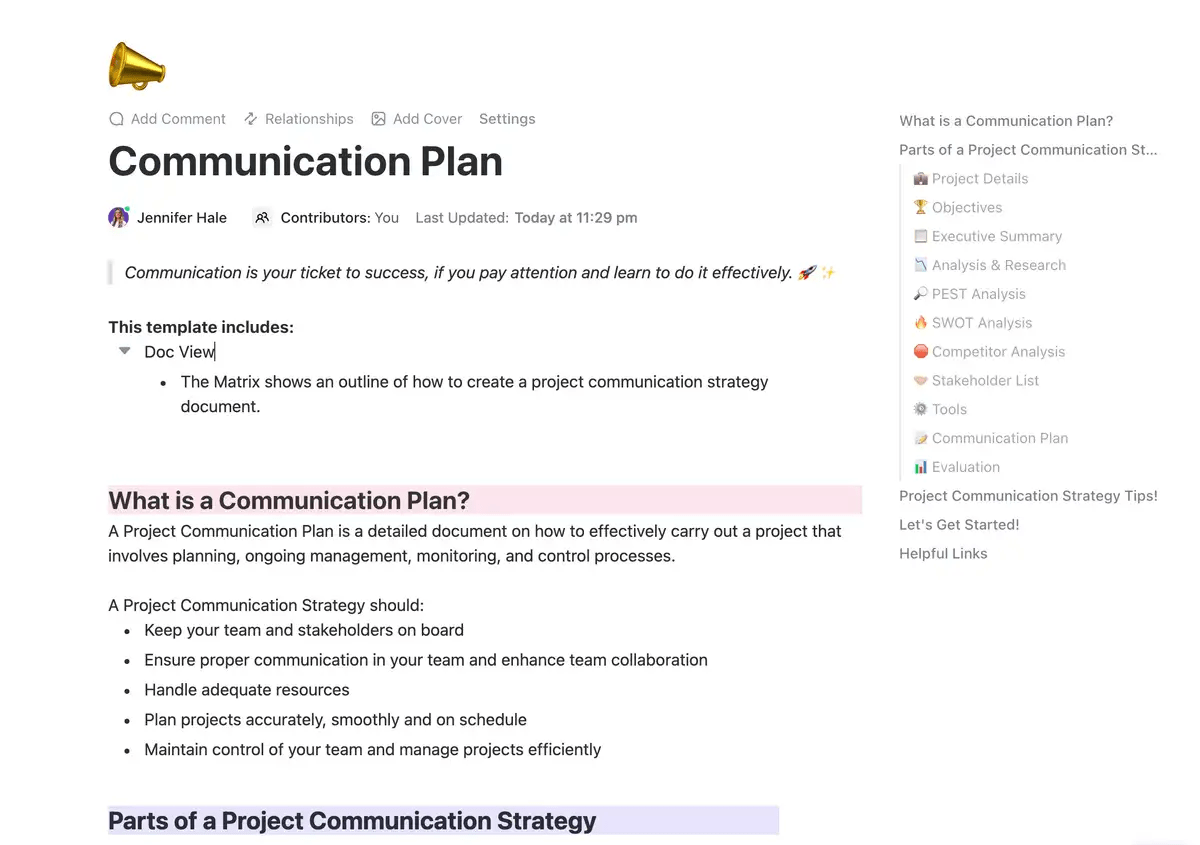ربما تكون قد رأيت ذلك من قبل: تعثر المشروع، ليس بسبب نقص الجهد، ولكن بسبب تقاطع الرسائل، وعدم فهم الأشخاص لبعضهم البعض تمامًا.
إنها مشكلة شائعة، ولكن لا يجب أن تكون كذلك.
يمكن أن تقدم نماذج التواصل منظورًا جديدًا حول كيفية تفاعل فريقك، مما يساعد على إزالة الالتباس وخلق تدفق أكثر انفتاحًا للأفكار.
في هذه المدونة، سنشرح لك كيفية عمل هذه النماذج وكيف يمكنك استخدامها لتعزيز التعاون داخل فريقك. 👥
ما هو نموذج التواصل؟
نموذج التواصل هو إطار عمل مبسط يساعد على شرح كيفية تبادل المعلومات بين الأشخاص.
وهو يقسّم عملية التواصل البشري المعقدة إلى مكونات رئيسية، يوضح كيفية إرسال الرسائل واستقبالها وتفسيرها.
يتضمن كل نموذج بشكل عام عناصر أساسية مثل
- المرسل، وهو الذي يبادر بالرسالة
- و المتلقي، الذي يفسر الرسالة؛ و الرسالة نفسها
- القناة التي يتم من خلالها توصيل الرسالة (مثل الخطاب أو النص أو الوسائط الرقمية)
- التغذية المرتدة، التي تسمح للمرسل بمعرفة ما إذا كانت رسالته قد فُهمت أم لا
ومن الجوانب المهمة الأخرى الضوضاء، أي كل ما يشوش أو يتداخل مع عملية التواصل، من الضوضاء الخلفية الحرفية إلى الحواجز العاطفية أو النفسية.
وقد ازدادت أهمية هذه النماذج في العصر الحديث، حيث غالباً ما تؤدي التكنولوجيا والتفاعل العالمي إلى تعقيد التواصل. فهي توفر الوضوح والهيكلية لتمكين تبادل أكثر سلاسة، مما يساعد الأفراد والشركات على تحسين التواصل.
8 أنواع نماذج التواصل
يشكل التواصل كل جانب من جوانب حياتنا، ولكن ما مدى فهمنا له؟
هناك طرق متعددة لفهم الرسائل التي نرسلها ونتلقاها يوميًا بدءًا من نماذج الإرسال والتفاعل في التواصل إلى السياقات المادية والنفسية، فهناك طرق متعددة لفهم الرسائل التي نرسلها ونتلقاها يوميًا.
دعونا نستكشف ثمانية نماذج تواصل رئيسية مع أمثلة. 📝
نموذج التواصل عند أرسطو
يعد نموذج التواصل لأرسطو من بين أقدم وأبسط المناهج. وهو يركز على الإقناع، مما يجعله وثيق الصلة بالخطابة والبلاغة بشكل خاص.
ويؤكد هذا النموذج على قدرة المتحدث على التأثير على الجمهور من خلال تدفق التواصل في اتجاه واحد.
والفكرة الأساسية هنا هي أن المتكلم (المرسل) يعد رسالة لتحريك المستمع (المتلقي) نحو فعل أو فهم معين. وعادةً ما تكون القناة هي التواصل اللفظي، حيث يكون الوضوح وأساليب الإقناع هي المفتاح.
من وجهة نظر أرسطو، يجب على المتكلم مراعاة ثلاثة عوامل حاسمة:
- الأخلاق (المصداقية)
- الباثوس (الجاذبية العاطفية)
- اللوغوس (الحجة المنطقية)
عندما يوازن المتكلم بين هذه العناصر، يمكنه إشراك الجمهور بشكل فعال، مما يضمن صدى الرسالة.
📌 📌مثال على ذلك: يعتبر السياسي الذي يلقي خطابًا خلال حملة انتخابية تطبيقًا مباشرًا لنموذج أرسطو. يصوغ المتكلم رسالته لإقناع الناخبين من خلال بناء المصداقية، ومخاطبة العواطف، وإثارة النقاط المنطقية.
🧠 هل تعلم؟ لا يزال نموذج أرسطو للتواصل مؤثرًا للغاية في دراسات التواصل المعاصرة. فقد وضع الأساس لفهم فن الإقناع وغالبًا ما يتم تدريسه في دورات الخطابة والبلاغة.
نموذج التواصل لأرسطو
يسلط نموذج SMCR الذي وضعه منظّر الاتصالات الأمريكي ديفيد كينيث بيرلو -المصدر، الرسالة، القناة، المتلقي- الضوء على أهمية العوامل الفردية في عملية التواصل.
ويركز على مهارات ومواقف ومعرفة كل من المرسل والمستقبل.
يعتقد بيرلو أن التواصل الفعال يعتمد على مدى فهم كل طرف للرسالة. يسلط هذا النموذج الضوء على كيفية تأثير خلفية المرسل ومهارات التواصل ومستوى المعرفة على إنشاء الرسالة وتسليمها.
وبالمثل، تؤثر مهارات المتلقي وثقافته وخبراته على كيفية تفسيره للرسالة.
كما يسلط هذا النموذج الضوء على أهمية اختيار القناة المناسبة (مثل التواصل اللفظي أو المكتوب أو غير اللفظي) للتأكد من أن المتلقي يفسر الرسالة على النحو المنشود.
📌 📌مثال: في بيئة الفصل الدراسي، يستخدم المعلم (المصدر) كلاً من التفسيرات اللفظية والوسائل البصرية (القناة) لضمان فهم الطلاب (المتلقين) الذين لديهم أساليب تعلم مختلفة للدرس. يشكل فهمهم الفردي بشكل مباشر كيفية تلقيهم للرسالة.
نموذج لاسويل للاتصال أو معادلة لاسويل
تم تقديمها في عام 1948 من خلال كتاب _السياسة: يطرح نموذج هارولد لاسويل خمسة أسئلة رئيسية، يطرح نموذج هارولد لاسويل خمسة أسئلة رئيسية: "من يقول ماذا، وفي أي قناة، ولمن ولمن وبأي تأثير؟
هذا النموذج مفيد بشكل خاص في التواصل الجماهيري ويركز على تأثير الرسالة. فهو مصمم لفهم عملية التواصل الإعلامي وآثارها، ويسلط الضوء على المرسل، والرسالة التي يرسلها، والوسيلة المستخدمة لإيصال الرسالة، والجمهور الذي يتلقاها، وتأثيرها.
ويوفر نموذج لاسويل طريقة مباشرة لتحليل الاتصال في البيئات واسعة النطاق، مثل الإعلانات أو العلاقات العامة أو التغطية الإعلامية، ويركز على تتبع تأثير الرسالة من المنشأ إلى الاستقبال.
📌 مثال: في حملة تسويقية، تقوم وكالة إعلانية (من) بصياغة رسالة (ماذا) وبثها على وسائل التواصل الاجتماعي (أي قناة) للوصول إلى جيل الألفية (لمن) بهدف زيادة مبيعات المنتج (بأي تأثير).
🧠 هل تعلم؟ وفقًا لنظرية التواصل في الإدارة المنسقة للمعنى (CMM)، يولد القائمون على التواصل حقائق اجتماعية من خلال تفاعلاتهم. وهذا يعني أن كل محادثة لا تتعلق فقط بتبادل الكلمات، بل تتعلق بـ خلق المعاني المشتركة وتشكيل الطريقة التي نفهم بها العالم من حولنا ونختبره.
نموذج شانون وويفر للتواصل
قام كلود شانون ووارن ويفر ببناء نموذج التواصل المعروف باسم النظرية الرياضية للتواصل في عام 1948. ولا يزال هذا النموذج يعتبر أم جميع النماذج، وقد نشأ من الاتصالات السلكية واللاسلكية.
يقدم هذا النموذج مفهوم الضوضاء كعامل يتداخل مع نقل الرسائل، مما يجعله قابلاً للتطبيق بشكل كبير على كل من التواصل بين الأشخاص والتواصل التكنولوجي.
مكوناته الأساسية هي المرسل وجهاز التشفير والقناة وجهاز فك التشفير وجهاز فك التشفير وجهاز الاستقبال.
وقد أولى شانون وويفر اهتمامًا خاصًا ل التحديات التقنية في التواصل، مع التركيز على كيفية تشويه الإشارة (الرسالة) أثناء الإرسال.
يمكن أن تأتي الضوضاء بأشكال عديدة، بما في ذلك التشويشات المادية أو سوء الفهم، ويساعد النموذج في تحديد هذه التشويشات وتقليلها.
📌 📌مثال: قد يواجه العميل الذي يتصل بمركز الدعم تشويشًا على خط الهاتف، مما يعطل الرسالة. يؤثر التشويش التقني على الاتصال هنا، مما قد يؤدي إلى سوء الفهم.
نموذج أوسغود-شرام للتواصل
يبتعد هذا النموذج الذي طوره تشارلز إجيرتون أوسغود وويلبر شرام عن التواصل الخطي ويؤكد على التواصل الدائري، مما يجعله أحد نماذج التفاعل القليلة.
يقوم كل من المرسل والمستقبل بتبديل الأدوار باستمرار كمشفر ومترجم وفك تشفير.
يصبح التواصل أكثر تفاعلاً ذهاباً وإياباً، مع التركيز على تفسير الرسائل بدلاً من مجرد الإرسال. وهذا يجعل نموذج أوسغود-شرام مثاليًا للحوارات أو أي موقف تكون فيه التغذية الراجعة فورية.
وهو مناسب بشكل خاص في التواصل بين الأشخاص، حيث يتم تحقيق التفاهم من خلال التفاعل المستمر بين الأطراف المعنية.
📌 📌مثال: صديقان يتناقشان في موضوع ما خلال محادثة غير رسمية يرسلان ويستقبلان الرسائل، ويقدمان تغذية راجعة فورية ويفسران كلمات بعضهما البعض في الوقت الفعلي.
نموذج ويستلي وماكلين للتواصل
يتوسع بروس ه. ويستلي ومالكولم س. ماكلين جونيور في نماذج التواصل السابقة من خلال دمج دور حراس البوابة - الأفراد أو الكيانات التي تتحكم في تدفق التواصل.
ويكتسب هذا النموذج أهمية كبيرة في مجال الاتصال الجماهيري حيث يقرر المحررون والصحفيون ومشرفو المحتوى ما هي الرسائل التي تصل إلى الجمهور
كما يسلط هذا النموذج الضوء على السياق الفيزيائي والنفسي الذي يحدث فيه التواصل، مع الأخذ بعين الاعتبار التأثيرات البيئية والاجتماعية التي يمكن أن تؤثر على تفسير المعلومات وتدفقها.
كما أن حلقة التغذية الراجعة ضرورية هنا أيضًا. فهي تضمن قدرة كل من الجمهور والمرسل على التأثير على تصرفات وقرارات بعضهما البعض، مما يجعلها أكثر تفاعلية.
📌مثال: في غرفة الأخبار، يقرر الصحفيون القصص التي يتم بثها على الهواء. قد يقوم المنتج (حارس البوابة) بتعديل المحتوى ليتناسب مع تفضيلات الجمهور قبل أن يصل إلى المشاهدين.
نموذج بارنلاند للاتصالات التبادلية
يعد نموذج دين بارنلند أحد نماذج التواصل التبادلي. ويشدد على أن التواصل هو عملية ديناميكية متزامنة حيث يشارك كل من المرسل والمستقبل بنشاط.
يسلط النموذج الضوء على أن الناس يرسلون ويستقبلون الرسائل بشكل مستمر سواءً شفهياً أو غير شفهي، حيث تشكل خلفية كل شخص وخبراته السابقة وسياقه كيفية ترميز الرسائل وفك تشفيرها، مما يجعل التواصل فريداً من نوعه في كل تفاعل.
ويُعد نموذج بارنلاند مفيدًا بشكل خاص في السيناريوهات التي يحتاج فيها الأشخاص إلى الانخراط في محادثات متعددة الأوجه، مثل المفاوضات التجارية، حيث يأخذ بعين الاعتبار كلاً من العوامل الشخصية و العوامل البيئية.
📌مثال على ذلك: خلال اجتماع عمل، يتبادل المشاركون المعلومات الشفهية ويترجمون لغة الجسد ونبرة الصوت، مما يضيف طبقات إلى عملية التواصل.
نموذج التواصل الحلزوني لـ دانس
ينظر نموذج فرانك دانس الحلزوني للتواصل على أنه عملية مستمرة ومتطورة تدور في شكل حلزوني تصاعدي مثل اللولب.
ويقرّ النموذج بأنه عندما يتواصل الناس، فإن رسائلهم تعتمد على تفاعلاتهم السابقة، كما يؤكد على أن التواصل ليس له نقطة بداية أو نهاية ثابتة بل يتغير باستمرار مع مرور الوقت، حيث تؤثر التجارب الجديدة على التفاعلات المستقبلية.
هذا النهج مفيد عند تحليل التواصل طويل الأمد، كما هو الحال في الصداقات أو علاقات العمل المستمرة، حيث تعتمد كل محادثة على المحادثات السابقة.
📌 📌مثال: المدير الذي عمل مع فريقه لسنوات سيكيف أسلوب تواصله بناءً على التفاعلات السابقة، مما يجعل كل محادثة أكثر ثراءً ودقة من سابقتها.
🧠 هل تعلم؟ التواصل الأفقي يشير إلى تبادل المعلومات بين الزملاء أو أعضاء الفريق على نفس المستوى التنظيمي. وهو يتماشى مع العديد من نماذج التواصل، مع التأكيد على أهمية التفاعل بين الأقران في التبادل الفعال للمعلومات.
التطبيقات العملية لنماذج التواصل
تعمل نماذج التواصل على تعزيز الإنتاجية من خلال هيكلة واضحة للرسائل. فهي تمكّن الفرق من نقل الأفكار بفعالية وتقلل من سوء الفهم.
على سبيل المثال، يمكن للفرق تطبيق نموذج شانون وويفر من خلال تحديد العوائق المحتملة أمام التواصل الفعال، مثل المصطلحات التقنية أو الرسائل غير الواضحة. عندما تعطي الفرق الأولوية للوضوح وتختار طرق التواصل الصحيحة - سواء كانت رسائل البريد الإلكتروني أو الاجتماعات أو أدوات إدارة المشروع - يصبح التعاون أكثر سلاسة.
يمكن للفرق استخدام نموذج بيرلو للتواصل لصياغة رسائل مصممة خصيصًا لجمهورها المحدد بحيث تكون المعلومات التي يتم مشاركتها ذات صلة ومفهومة.
ويؤدي هذا التركيز على الرسائل الواضحة إلى تعزيز بيئة يشعر فيها أعضاء الفريق بأنهم أكثر ارتباطًا بمهامهم، مما يشجع على التعاون على الأهداف المشتركة.
في العمل
فيما يلي بعض السيناريوهات الواقعية التي تم فيها تطبيق نماذج أكثر تعقيدًا للتواصل بنجاح:
الرعاية الصحية
في مجال الرعاية الصحية، يعد التواصل الفعال أمرًا حيويًا لرعاية المرضى.
يدعم نموذج بيرلو للتواصل تدريب المهنيين الطبيين لتعزيز مهارات التواصل. يؤدي التواصل الواضح فيما يتعلق بخيارات العلاج، إلى جانب مصداقية مقدم الخدمة، إلى نتائج أفضل للمريض.
بالإضافة إلى ذلك، يؤدي استخدام نموذج أوسغود-شرام للتواصل إلى تسهيل التواصل الفعال والتعاون، مما يؤكد فهم المرضى لخططهم العلاجية.
التسويق
في مجال التسويق، يساعد نموذج لاسويل الفرق في صياغة رسائل واضحة. إن تحليل من يوصل الرسالة والمحتوى والوسيلة والجمهور المستهدف يمكّن المسوقين من تطوير استراتيجيات تلقى صدى.
على سبيل المثال، يمكن أن يؤدي إطلاق حملة من خلال المؤثرين على وسائل التواصل الاجتماعي إلى استهداف فئات سكانية محددة بشكل فعال.
يركز نموذج ويستلي وماكلين على حلقة التغذية الراجعة، مما يسمح للفرق بتحسين استراتيجياتها بناءً على ردود أفعال المستهلكين، مما يؤدي إلى نتائج تسويقية أكثر نجاحًا.
التعليم
في التعليم، يعمل نموذج أرسطو على تحسين هيكلة الدروس.
حيث يقوم المعلمون بإشراك الطلاب من خلال ترسيخ المصداقية وإقامة روابط عاطفية من خلال الحجج المنطقية. تعزز التجارب الشخصية التي يتم مشاركتها في الدروس إمكانية الارتباط والفهم.
وعلاوة على ذلك، يتيح نموذج بارنلاند للتواصل التفاعلي للمعلمين تعديل أساليب التدريس الخاصة بهم استجابةً لملاحظات الطلاب. وهذا بدوره يعزز التعاون ويخلق بيئة تعليمية أكثر تفاعلية.
## كيفية تعزيز التواصل باستخدام هذه النماذج
نماذج التواصل هي أدوات أساسية يمكن تطبيقها بفعالية باستخدام المنصات الرقمية المناسبة. كليك أب بمجموعته المتنوعة من الميزات، على مساعدة الفرق على تنفيذ نماذج التواصل التفاعلية هذه لتعزيز الإنتاجية والتعاون والوضوح.
نستكشف أدناه كيف يدعم التواصل ويتماشى مع المبادئ الموجودة في نماذج التواصل المختلفة.
انقر فوق تعليقات المهام تعليقات مهمة النقر فوق المهمة يساعد الفرق على تطبيق المساءلة، والتأكد من أن الجميع يعرف من المسؤول عن إجراءات أو مهام محددة. هذا يقلل من سوء الفهم ويضمن عدم ضياع النقاط الرئيسية في سلسلة طويلة من الرسائل.

تحويل تعليقات ClickUp تعيين التعليقات إلى مهام للتواصل الناجح بين الفرق
على سبيل المثال، في مشروع تطوير منتج، يمكن لمدير المشروع ترك تعليقات مفصلة على تصميم ميزة ما. يمكن للمصمم بعد ذلك الرد مباشرةً داخل المهمة، ومعالجة التعليقات دون التنقل بين رسائل البريد الإلكتروني أو الرسائل المبعثرة.
تحافظ القدرة على تنظيم هذه المناقشات على مستوى المهمة مباشرةً على مركزية التواصل وسهولة الوصول إليه.
مستندات النقر فوق المستندات مستندات ClickUp أداة قوية للفرق التي تحتاج إلى التعاون في الوقت الفعلي.
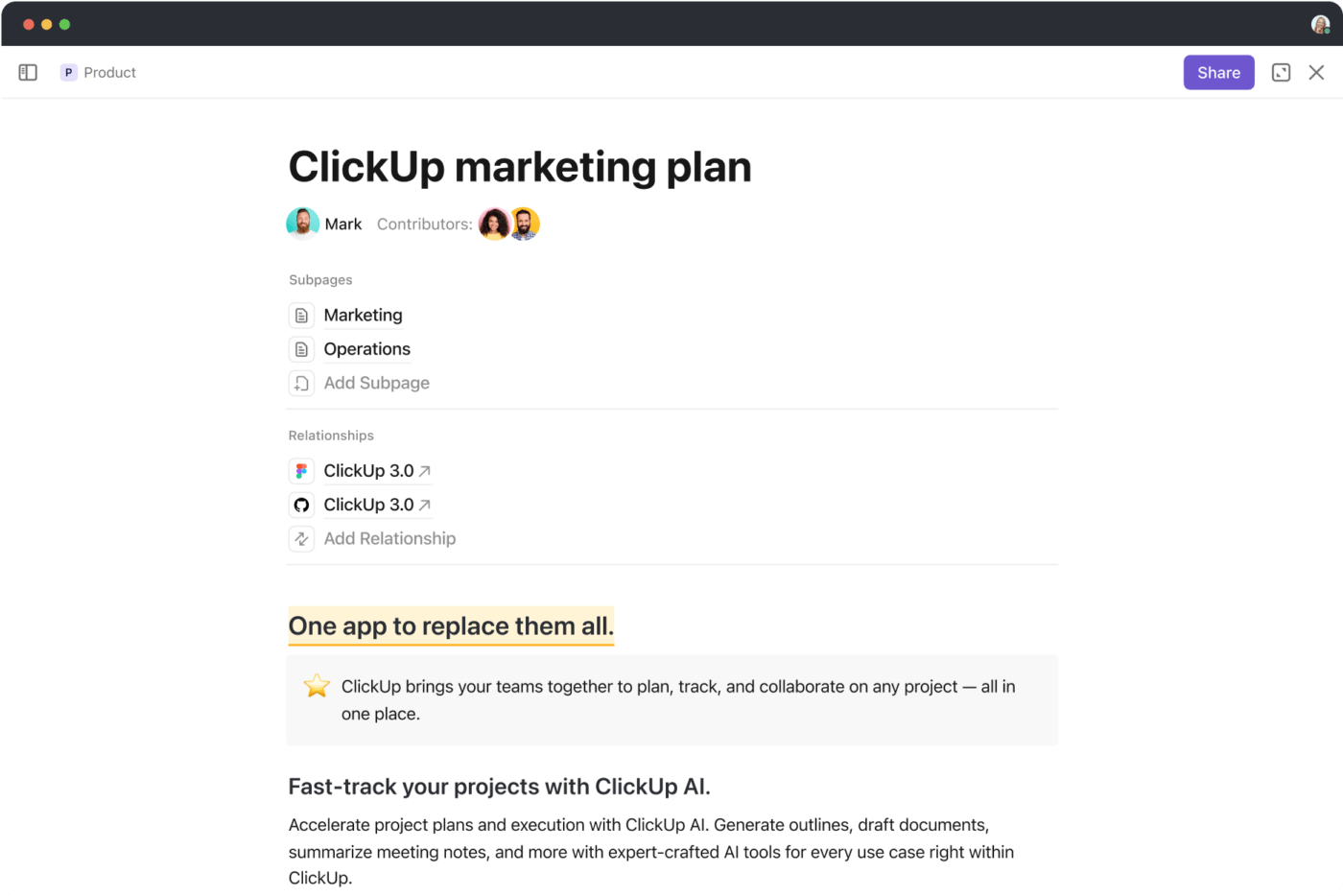
إنشاء المعرفة ومشاركتها بسلاسة مع مستندات ClickUp Docs
باستخدام مستندات المستندات، يمكن للفرق إنشاء المستندات ومشاركتها وتحريرها بشكل تعاوني، مما يسهل وضع الخطط أو كتابة التقارير أو تبادل الأفكار دون مغادرة مساحة عمل ClickUp.
يتوافق مستندات المستندات مع نموذج التواصل Osgood-Schramm، حيث تتوافق مع نموذج التواصل Osgood-Schramm، حيث جالتعليقات المستمرة والوقت الحقيقي تعاون الفريق أمر بالغ الأهمية.
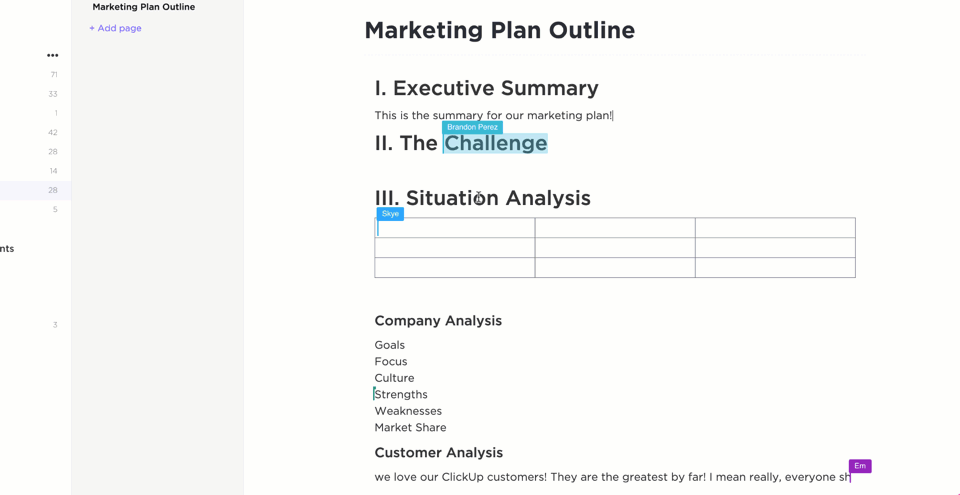
تمكين التغذية الراجعة والتفاعل في الوقت الفعلي بين أعضاء الفريق، تماماً كما هو الحال في نماذج المعاملات في التواصل، مع ClickUp Docs
عندما تتمكن الفرق من العمل معًا على مستند واحد، فإن ذلك يحاكي عملية ترميز المعلومات وفك تشفيرها، حيث يرسل الطرفان الملاحظات ويتلقونها باستمرار. وهذا يمنع التأخير في التواصل ويعزز بيئة مثمرة وتعاونية.
على سبيل المثال، يمكن لفرق التسويق استخدام مستندات ClickUp Docs للتعاون في خطة حملة.
يمكن لأعضاء الفريق المختلفين المساهمة بالأفكار وترك التعليقات وتحديث المستند في وقت واحد. وهذا يحسن التعاون، ويعمل الجميع بنفس المعلومات المحدثة، مما يقلل من الارتباك.
### لوحات وايت بورد ClickUp Whiteboards اللوحات البيضاء ClickUp Whiteboards توفر طريقة مرئية للتعاون، مما يجعلها مثالية لجلسات العصف الذهني أو تخطيط العمليات أو حتى نمذجة تدفقات التواصل.
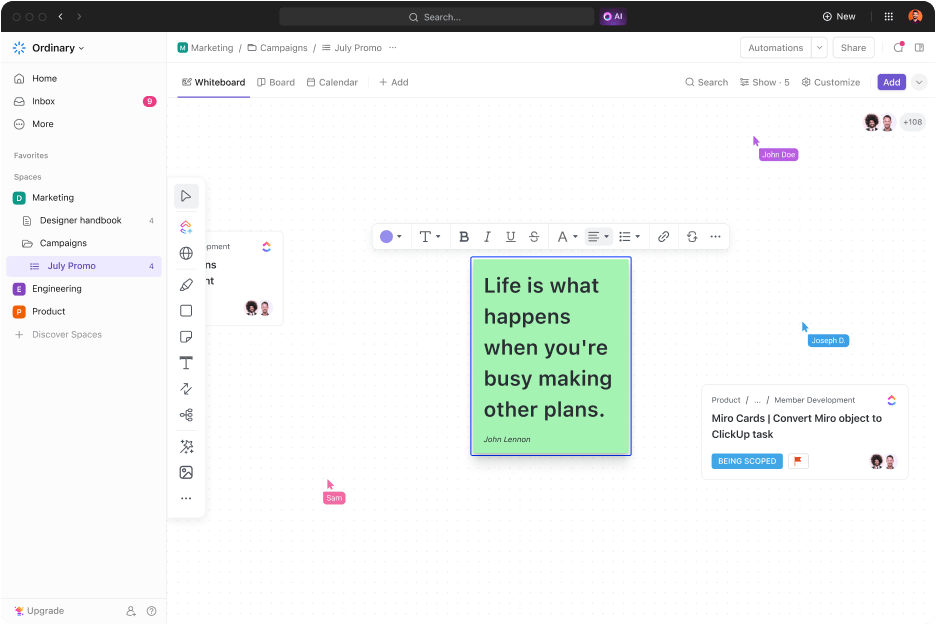
شجع على التواصل التفاعلي والعمل الجماعي الديناميكي باستخدام سبورات ClickUp Whiteboards
يعد التواصل المرئي أكثر فعالية في نقل الأفكار المعقدة، وتوفر السبورات البيضاء (مثل السبورات البيضاء المادية) مساحة تفاعلية للفرق للعمل معاً.
تعمل هذه الأداة على تعزيز التواصل من خلال دعم المفاهيم الموجودة في نماذج التواصل مثل شانون وويفر، حيث يكون وضوح الرسالة وتقليل الضوضاء أمرًا حيويًا.
على سبيل المثال، قد يستخدم فريق تطوير البرمجيات اللوحات البيضاء لتخطيط سير عمل المشروع. يضمن التمثيل المرئي للمهام والجداول الزمنية والتبعيات أن يفهم كل عضو في الفريق الخطة.
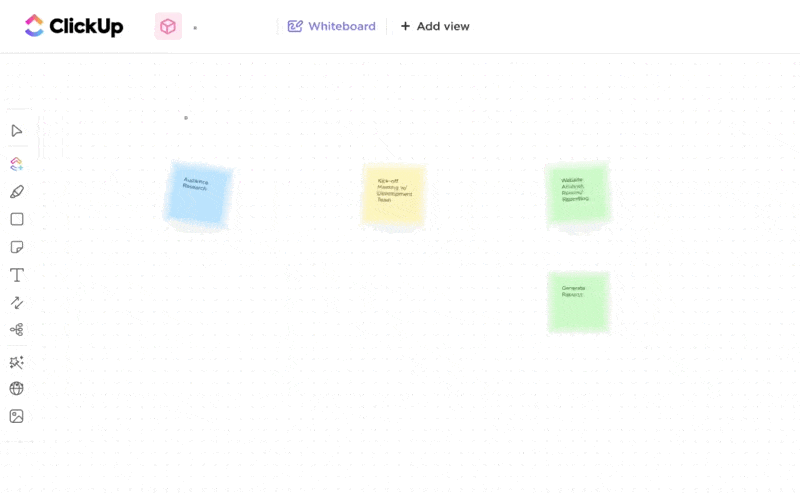
تعاون مع فريقك دون عناء باستخدام سبورات ClickUp Whiteboards
تقلل مثل هذه الوسائل المرئية أيضًا من سوء التواصل في مكان العمل حيث يمكن للجميع رؤية الصورة الكبيرة.
ساعدت ميزة ClickUp فريقنا على التواصل في فريق العمل عن بُعد في مناطق زمنية مختلفة ومعرفة ما يجري في المشروع دون الحاجة إلى عقد اجتماعات غير ضرورية أو طلب معلومات من الأشخاص عبر البريد الإلكتروني أو Slack. تساعدنا ميزة السبورة البيضاء على تبادل الأفكار حول العمليات وسير العمل وتعيين المهام في الوقت الفعلي.
دانييل بوش، مديرة مشروع في EDforTech على ClickUp
محادثة ClickUp
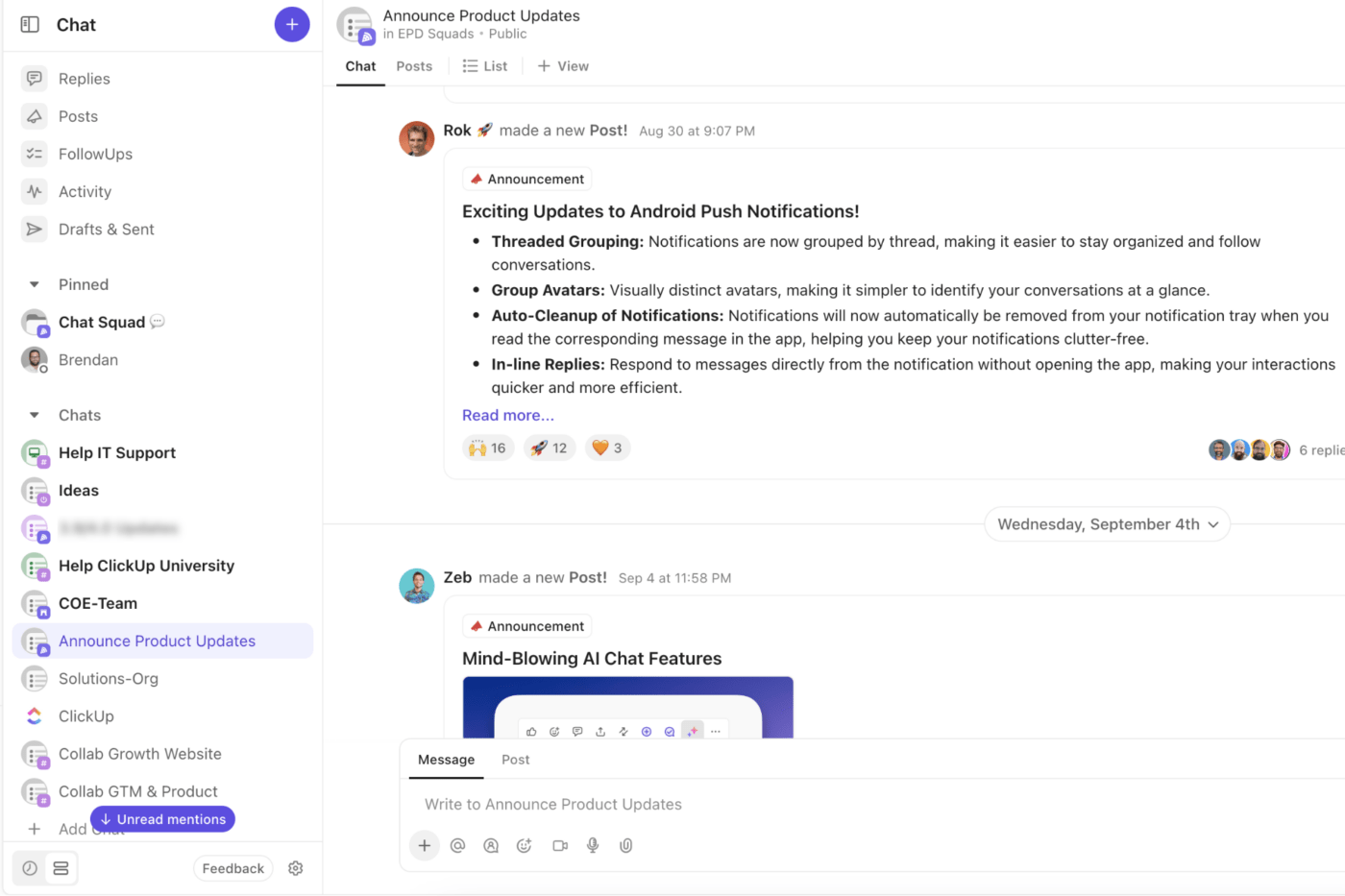
حافظ على تدفق الحوار مع ClickUp Chat، مما يعزز التواصل الواضح والمستمر ClickUp Chat يوفر مساحة داخل التطبيق للتراسل الفوري، مما يتيح التواصل في الوقت الفعلي داخل فرق العمل.
على عكس سلاسل رسائل البريد الإلكتروني الطويلة، والتي قد يصعب متابعتها، تتيح الدردشة محادثات فورية وواضحة وموجزة، مما يجعلها أداة مثالية للتحديثات السريعة والأسئلة السريعة.
فيما يتعلق بنماذج التواصل، تتوافق الدردشة مع مفهوم حلقة التغذية المرتدة الذي نراه في نماذج مثل أوسغود-شرام حيث التفاعل المستمر والردود الفورية أمر بالغ الأهمية.
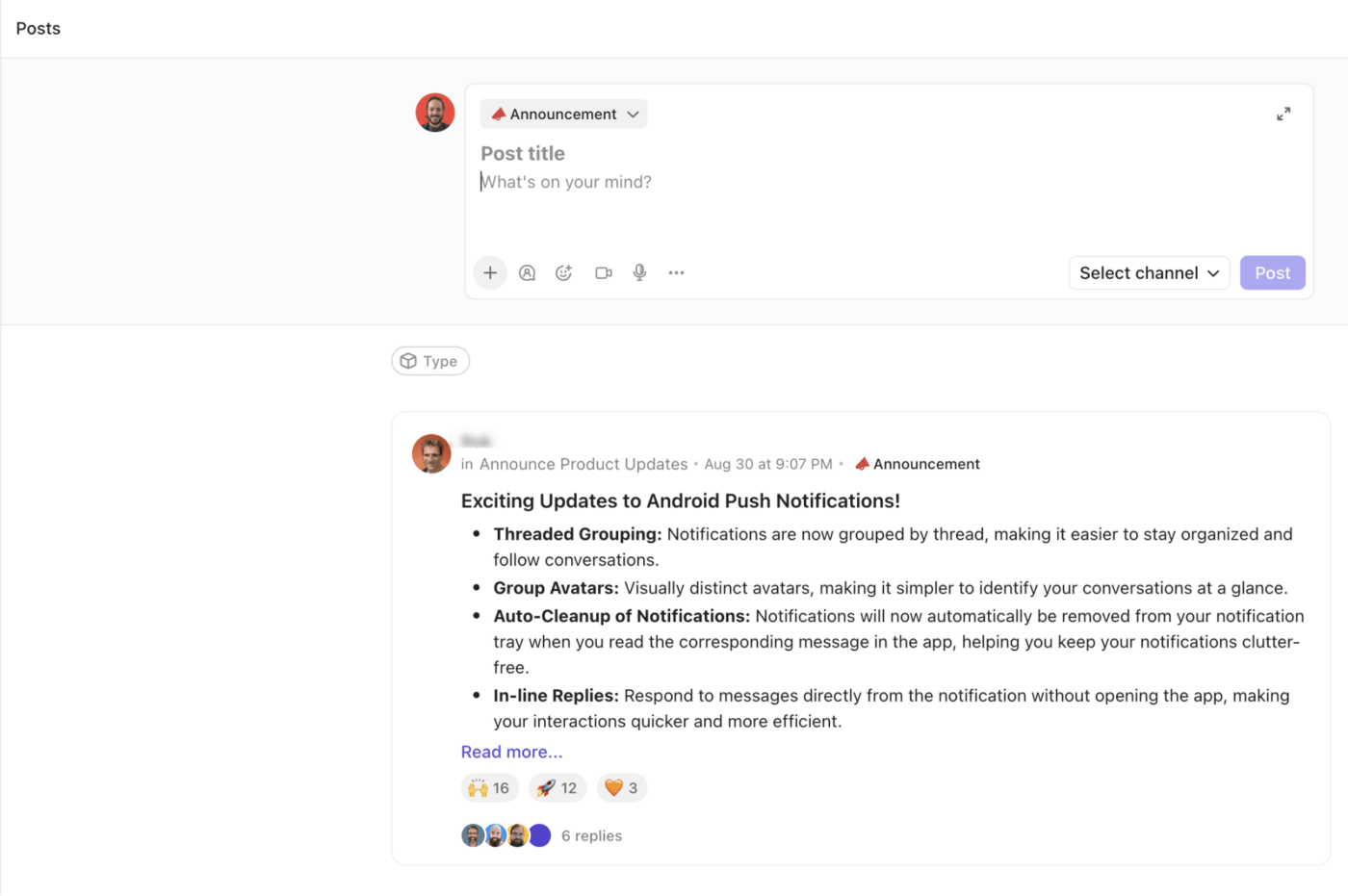
نشر الإعلانات عبر قنوات مختلفة باستخدام ClickUp Chat
يمكن للفرق التي تحتاج إلى التواصل بشكل متكرر وفعال استخدام الدردشة للبقاء على اتصال والتأكد من فهم الرسائل على الفور.
على سبيل المثال، أثناء يوم عمل مزدحم، يمكن لأعضاء الفريق استخدام ClickUp Chat للتحقق من تحديثات المشروع بسرعة، أو طلب توضيحات، أو مشاركة المعلومات ذات الصلة دون ازدحام تعليقات المهام أو البريد الإلكتروني الوارد. يؤدي ذلك إلى تسريع عملية اتخاذ القرار ويحافظ على توافق الفريق.
مقاطع النقر فوق المقاطع كليك أب كليب يأخذ التواصل خطوة إلى الأمام من خلال السماح لأعضاء الفريق بإنشاء رسائل فيديو قصيرة ومشاركتها.
تساعد هذه المقاطع في تقديم توضيحات مفصّلة أو تعليمات مرئية أو ملاحظات، خاصةً عندما لا يكون التواصل النصي كافياً.
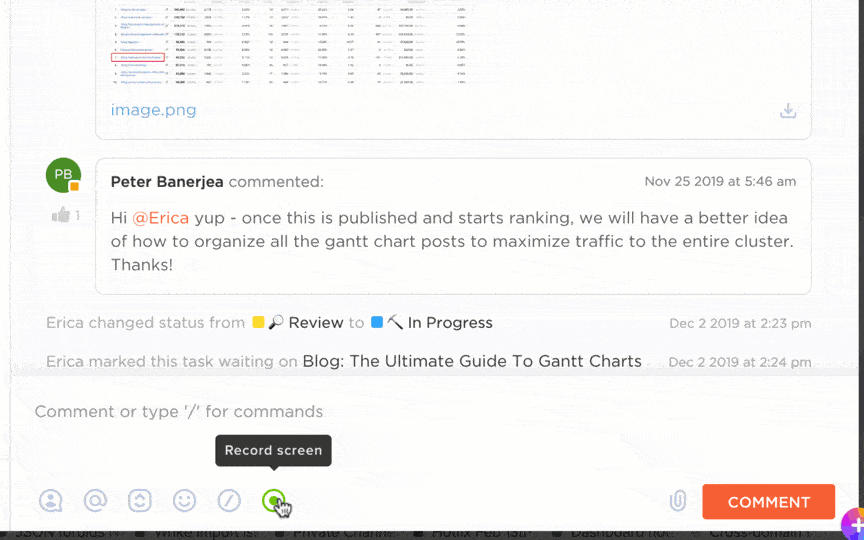
تضمين ClickUp Clips في المهام لالتقاط الأفكار ومشاركتها على الفور
تُعد المقاطع أداة ممتازة للتوافق مع نماذج التواصل التي تبرز الوضوح ونقل الرسائل بفعالية، مثل شانون وويفر.
يسمح لك استخدام الفيديو بتجنب التفسيرات الخاطئة التي غالباً ما تحدث مع التواصل المكتوب، مما يضمن إيصال رسالتك كما هو مقصود تماماً.
على سبيل المثال، قد يقوم مدير المشروع بتسجيل مقطع فيديو سريع يشرح فيه عملية جديدة للفريق، مع استعراض كل خطوة على الشاشة.
تعتبر طريقة التواصل هذه مفيدة بشكل خاص لفرق العمل عن بُعد، حيث توفر لمسة شخصية وتزيل الضوضاء المحتملة التي يمكن أن تشوش على الرسالة في شكل مكتوب.
💡 نصيحة للمحترفين: لماذا لا تزيد من مشاركة الفريق مع بعض أنشطة بناء الفريق الافتراضية ? فكر في المسابقات التافهة أو ألعاب حل المشكلات الممتعة. إنها طريقة رائعة لكسر الجليد وجعل الجميع يتعاونون في أجواء مرحة.
تكامل النقر فوق التكامل
يقلل ClickUp من تجزئة الرسائل ويساعد الفرق في الحفاظ على تنظيمها من خلال أكثر من 1000 تكامل.
تدعم الاتصالات المركزية مفاهيم نموذج لاسويل، حيث يجب صياغة الرسائل بعناية ونقلها عبر القنوات الصحيحة للوصول إلى الجمهور المستهدف بفعالية.
مع تكامل ClickUp ، يمكن لأعضاء الفريق الوصول إلى الاتصالات المهمة من أدوات متعددة دون مغادرة المنصة، مما يسهل التعاون ويقلل من احتمالات ثغرات التواصل .

ابقَ على اطلاع دائم مع التنبيهات الفورية للتعليقات وتحديثات المهام المرسلة مباشرةً إلى Microsoft Teams باستخدام تكامل ClickUp
على سبيل المثال، قد يستخدم فريق التسويق Microsoft Teams للرسائل السريعة و Zoom لمكالمات الفيديو، ولكن يتم ربط جميع تحديثات المشروع الرئيسية والقرارات والمستندات مباشرةً داخل ClickUp.
قالب خطة اتصال ClickUp
إحدى أقوى الطرق لتحسين التواصل الجماعي من خلال وضع خطة تواصل واضحة.
تم تصميم نموذج خطة التواصل من ClickUp لمساعدتك في تخطيط وتنسيق المحادثات مع أصحاب المصلحة.
ال قالب خطة التواصل* قالب خطة التواصل* تنظيم التواصل وتحسينه في مؤسستك.
فهو يوفر طريقة منظمة لتعيين واضح لـ أهداف التواصل والجداول الزمنية وتحديد أصحاب المصلحة الرئيسيين من أجل رسائل داخلية وخارجية متسقة وفعالة. وسواء كنت تهدف إلى تعزيز مشاركة العملاء أو تحسين المناقشات الداخلية، فإن النموذج يرشدك في تحديد الأهداف المخصصة.
يمكنك أيضًا تحديد أفضل طرق التواصل، سواء كان ذلك من خلال البريد الإلكتروني أو وسائل التواصل الاجتماعي أو أي قناة أخرى تتوافق مع جمهورك.
بالإضافة إلى ذلك، يتضمن القالب أدوات لتتبع تقدمك، مما يسمح لك بتحديد المعالم الرئيسية وقياس نجاح جهود التواصل الخاصة بك.
👀 المكافأة: اكتشف المزيد قوالب خطة التواصل لضمان إرسال رسائل واضحة وفعالة عبر جميع القنوات.
التغلب على عوائق التواصل
يلعب التواصل الفعال دورًا حيويًا في أي فريق، إلا أن هناك العديد من العوائق التي يمكن أن تعيق هذه العملية.
وتشمل العقبات الشائعة سوء الفهم والحمل الزائد للمعلومات والمشاكل التقنية.
غالبًا ما ينبع سوء الفهم من الرسائل غير الواضحة، مما يؤدي إلى الارتباك. يحدث الحمل الزائد للمعلومات عندما الإفراط في التواصل في العمل يربك المتلقين، مما يجعل من الصعب معالجة المعلومات بفعالية. تؤدي المشكلات التقنية، مثل ضعف الاتصال بالإنترنت أو أعطال البرامج، إلى تعطيل تدفق الاتصالات وإعاقة تعاون الفريق.
لمعالجة هذه التحديات، يمكن للفرق تطبيق نماذج التواصل مثل شانون وويفر ونموذج بيرلو.
يساعد نموذج شانون وويفر الفرق في تحديد الضوضاء المحتملة في التواصل، مما يسمح بوضع استراتيجيات تقلل من الانقطاعات. يشدد نموذج بيرلو على أهمية مهارات المرسل والمستقبل على حد سواء، وهو ما يمكن أن يوجه الفرق لتحسين رسائلها.
كما يمكن لـ ClickUp تعزيز التواصل والتغلب على العوائق.
على سبيل المثال كشف التعاون في ClickUp يخطر أعضاء الفريق عندما يقوم الآخرون بكتابة أو عرض مهمة ما، مما يوفر ملاحظات في الوقت الفعلي ويقلل من سوء الفهم. تحافظ هذه الرؤية على الوضوح للحفاظ على توافق الجميع.

تحرير المستندات معًا عبر الأنظمة الأساسية والبقاء على اطلاع دائم باستخدام ClickUp Instant Collaboration Detection
يساعد استخدام تعليقات المهام أعضاء الفريق على توضيح النقاط ومعالجة الأسئلة مباشرةً داخل المهمة، مما يعزز التواصل الواضح. وتوفر المستندات مساحة مركزية لمشاركة المعلومات المهمة، وهي منظمة بشكل منطقي لتسهيل الفهم دون إرباك المستلمين.
يؤدي التركيز على الوضوح والتفاعل في الوقت الفعلي إلى تعزيز ديناميكية الفريق المتماسكة والمتجاوبة، مما يؤدي في النهاية إلى تحسين التعاون والنتائج.
💡 نصيحة احترافية: لتجنب التحميل الزائد للمعلومات، حاول تحديد أوقات محددة خلال اليوم للتحقق من رسائل البريد الإلكتروني والرسائل بدلاً من مراقبتها باستمرار. يساعدك القيام بذلك على التركيز على المهام دون تشتيت الانتباه ويحافظ على صفاء ذهنك لعمل أعمق.
اجعل التواصل سلسًا مع ClickUp
تُعد نماذج التواصل ضرورية لتحسين الوضوح وتقليل سوء الفهم وتعزيز تعاون الفريق. فهي تكافح العوامل الذهنية والعاطفية لمساعدة الفرق على التواصل بفعالية وتعزيز الإنتاجية المؤسسية.
وتدعم أدوات مثل ClickUp هذه الجهود من خلال توفير منصة مركزية لتنظيم المهام، وتسهيل التعاون، والحفاظ على وضوح وفعالية التواصل.
هل أنت مستعد لتحسين تواصل فريقك؟ جرّب ClickUp اليوم واختبر التعاون السلس والإنتاجية بشكل مباشر!


